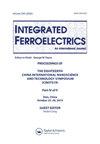Enhancement of Energy-Storage Properties and Temperature Stability in Complex Perovskite (1− x )NaNbO 3 − x Bi(Li 1/3 Sn 2/3 )O 3 Lead-Free Ceramics
IF 0.7
4区 工程技术
Q4 ENGINEERING, ELECTRICAL & ELECTRONIC
引用次数: 0
Abstract
AbstractIn general, NaNbO3 (NN) ceramics are considered to be one of the most promising lead-free perovskites (AFE) materials with low cost, low density, and nontoxic advantages. However, the energy storage capability of this material is often greatly hindered by the hysteresis exhibited during the transition from the antiferroelectric to the ferroelectric phase. In this study, lead-free dielectric (1−x)NaNbO3−xBi(Li1/3Sn2/3)O3, x = 0.0 − 0.08, ceramics were synthesized by solid-state reaction method. The XRD data show a structural change from orthorhombic to pseudo-cubic at x = 0.06 composition. With increasing Bi(Li1/3Sn2/3)O3 content, changes in dielectric properties demonstrated that the AFE P phase was successively replaced by the relaxor AFE R phase, resulting in a thin P–E loop characteristic which leads to the improvement of the energy storage density and efficiency of the ceramic capacitors. The optimum recoverable energy storage density (Wrec = 0.56 J/cm3) and efficiency (η = 74%) were obtained at x = 0.06 under an electric field of 120 kV/cm. The optimum composition also exhibited temperature stability in the range of 25 °C–100 °C. In addition, an increase in Bi(Li1/3Sn2/3)O3 content can lead to a decrease in leakage current density. This research shows that BLS modified NN ceramics are promising dielectric material candidates for energy storage applications.Keywords: Lead-free ceramicsNaNbO3energy storage properties AcknowledgmentsThe authors would like to express their sincere appreciation to Prof. Dr. Gobwute Rujijanakul for his invaluable support in utilizing the ferroelectric test system at Electroceramics research laboratory, Department of Physics and Materials Science, Faculty of Science, Chiang Mai University. Additionally, the authors extend their gratitude to Michelle Jennings for grammar check and proofreading.Disclosure StatementNo potential conflict of interest was reported by the author(s).Additional informationFundingThis work was financially supported from The National Science, Research, and Innovation Fund (NSRF) through Naresuan University (R2565B059).复合钙钛矿(1−x)NaNbO 3−x Bi(Li 1/3 Sn 2/3) o3无铅陶瓷储能性能和温度稳定性的增强
摘要NaNbO3 (NN)陶瓷具有低成本、低密度、无毒等优点,被认为是无铅钙钛矿(AFE)材料中最有前途的一种。然而,这种材料的能量存储能力往往受到从反铁电相到铁电相转变过程中所表现出的滞后的极大阻碍。本研究采用固相反应法制备了无铅介质(1−x)NaNbO3−xBi(li / 3sn2 /3)O3, x = 0.0−0.08。XRD数据显示,当x = 0.06时,结构由正交向拟立方转变。随着Bi(li / 3sn2 /3)O3含量的增加,陶瓷电容器的介电性能变化表明,AFE P相逐渐被弛豫剂AFE R相取代,形成了较薄的P - e环路特性,从而提高了陶瓷电容器的储能密度和效率。在120 kV/cm电场条件下,在x = 0.06时获得了最佳的可回收储能密度(Wrec = 0.56 J/cm3)和效率(η = 74%)。最佳组合物在25°C - 100°C范围内具有温度稳定性。此外,Bi(li / 3sn2 /3)O3含量的增加会导致漏电流密度的降低。该研究表明,BLS修饰的神经网络陶瓷是一种很有前途的储能介质材料。作者衷心感谢清迈大学理学院物理与材料科学系电陶瓷研究实验室Gobwute Rujijanakul教授对铁电测试系统的宝贵支持。此外,作者对Michelle Jennings的语法检查和校对表示感谢。披露声明作者未报告潜在的利益冲突。本研究由国家科学、研究和创新基金(NSRF)通过南京大学(R2565B059)资助。
本文章由计算机程序翻译,如有差异,请以英文原文为准。
求助全文
约1分钟内获得全文
求助全文
来源期刊

Integrated Ferroelectrics
工程技术-工程:电子与电气
CiteScore
1.40
自引率
0.00%
发文量
179
审稿时长
3 months
期刊介绍:
Integrated Ferroelectrics provides an international, interdisciplinary forum for electronic engineers and physicists as well as process and systems engineers, ceramicists, and chemists who are involved in research, design, development, manufacturing and utilization of integrated ferroelectric devices. Such devices unite ferroelectric films and semiconductor integrated circuit chips. The result is a new family of electronic devices, which combine the unique nonvolatile memory, pyroelectric, piezoelectric, photorefractive, radiation-hard, acoustic and/or dielectric properties of ferroelectric materials with the dynamic memory, logic and/or amplification properties and miniaturization and low-cost advantages of semiconductor i.c. technology.
 求助内容:
求助内容: 应助结果提醒方式:
应助结果提醒方式:


